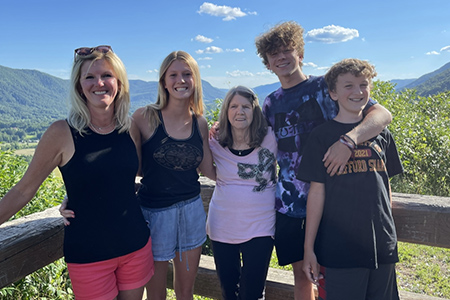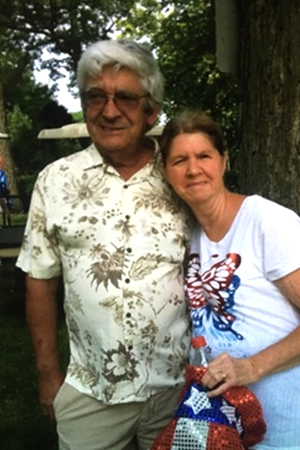Finding New Hope
When Emma Hall was told there was no way to treat her heart blockages without open heart surgery, she lost hope.
 It had already been a rough journey to get to this point.
It had already been a rough journey to get to this point.
“In 2021, I started having breathing issues,” says Emma, a 75-year-old retiree who lives in West Bloomfield. “I thought it was either a side effect from having COVID in 2020, or from smoking, since I used to smoke.”
Emma had also lost her husband in January 2020.
“It was a horrible year altogether,” says Emma’s daughter, Deborah Konarski. “There was a lot going on and we didn’t recognize her symptoms as heart related.”
Especially since Emma was already dealing with another health issue, advanced osteoporosis. It was affecting her back, and she underwent a kyphoplasty procedure, which used medical cement to fuse most of her vertebrae together. Then underwent another procedure to have a pain stimulator implanted, so she could be less dependent on opioids.
Emma’s new diagnosis, and a letdown
And yet, while these procedures were the family’s main focus, Emma’s breathing issues continued to affect her. Fortunately, she had just changed primary care doctors, and her new physician looked deeper.
“She sent me for a chest CT scan, and it showed that I had calcium in my heart arteries, which could be a sign of blockages,” Emma says.
The news was shocking, especially since Emma had never been diagnosed with any cardiovascular issues and she didn’t have a family history. She had never seen a cardiologist, but this changed—and quickly.
“I was referred to first one cardiologist, then a second one at the same health system,” Emma says.
They performed several tests, including an echocardiogram and MRI scan. In addition to the heart blockages, they also determined that Emma had an abdominal aortic aneurysm.
The aorta is the largest artery in the body, and it runs from the heart down to the abdomen, supplying blood to the body. When the wall of this blood vessel weakens, it can form an aneurysm, or bulge. If it ruptures, it can cause potentially fatal internal bleeding.
The second cardiologist attempted a catheter procedure to investigate Emma’s options for treating the heart blockages.
“I was uncomfortable,” Emma says. “I could feel everything they were doing, and I kept asking for more meds. I didn’t really feel like they were listening to me.”
“We were there for 14 hours,” Deborah says. “The doctor came out and said this was the longest cath procedure of his career, and that it wasn’t successful. He couldn’t reach my mom’s heart, and she wasn’t a candidate for stenting. He told us that open heart surgery was the only option.”
Deborah encouraged her mom to get the surgery, but Emma didn’t want to undergo another major procedure for several reasons, including pain management.
“I had gotten off of most of the opioids and had my pain management under control, and I didn’t want to go back to that,” Emma says. “At the same time, I knew my case was complex, especially given the shape of my aorta.”
While the aorta is normally shaped like a candy cane, Emma’s was twisted and curvy, making it challenging to perform a cath procedure.
“I told myself, ‘I guess this is it for me,’” Emma says.
A chance viewing
 Time passed, and Deborah continued to encourage her mom periodically to reconsider open heart surgery.
Time passed, and Deborah continued to encourage her mom periodically to reconsider open heart surgery.
“We were maybe a week out from revisiting this conversation when we saw a TV segment that changed everything,” Deborah says.
The Channel 4 story featured another patient, a 102-year-old World War II veteran. The patient needed a new heart valve, and he was treated successfully with a minimally invasive procedure at Henry Ford Health by Tiberio Frisoli, M.D., an interventional cardiologist.
“The technology at Henry Ford seemed promising,” Deborah says. “And we were encouraged, because it seemed like this other patient’s case was also complex. We called Dr. Frisoli’s office the next day.”
From the moment they arrived for their first meeting at Henry Ford Hospital in Detroit, they could tell this was going to be a different experience.
“They had the concierge service meet us right at the valet,” Deborah says. “They gave my mom a wheelchair and a welcome bag, and then escorted us up to Dr. Frisoli’s office. It was exceptional service.”
They also appreciated Dr. Frisoli’s bedside manner.
“He was super nice,” Emma says. “He had already reviewed my records from the other health system, but he re-read them aloud in front of us, explaining everything. He told me my case was challenging and that there were risks, but he had the technology and experience. And he was confident he could treat my heart blockages through another cath procedure. It gave me hope.”
Dr. Frisoli also made sure no stone was left unturned. They discussed Emma’s abdominal aortic aneurysm, and he reviewed it and measured it. He also elicited from her that she had been having some blood in her stool. He referred her to Henry Ford’s Gastrointestinal team to get clearance before the cath procedure, then started her on a trial of aspirin and Plavix—medications that would be necessary if she were able to receive heart stents.
“He also made a point of telling my mom that all of the torture and testing she went through at the other health system was ultimately worth it, because it gave him the info he needed to help her,” Deborah says. “Such a class act. It made both of us feel better after that horrible experience.”
Another cath procedure, and a different outcome
On the day of, I wasn’t nervous,” Emma says. “Dr. Frisoli completely put me at ease and gave me a sense of confidence.”
The procedure also felt different than her previous one.
“The communication was excellent,” Deborah says. “There was always someone there with us, keeping us posted. Another thing that was impressive was when my mom was uncomfortable and her back hurt, they took care of it instantly.”
And this time, the procedure was successful. Despite her twisted aorta, Dr. Frisoli was able to reach Emma’s heart and treat her heart blockages at the same time through stenting. She noticed an immediate improvement and was able to breathe better right away.
“Before I would run out of breath and feel weak even trying to do something as simple as vacuuming,” Emma says. “Now, I can clean my house, go grocery shopping, walk down to the beach and get on the boat—just live my life.”
While the procedure improved her symptoms, Dr. Frisoli referred Emma to a Henry Ford Health cardiologist to manage her heart health moving forward. And he encouraged Emma to enroll in Henry Ford’s Cardiac Rehabilitation program, given that lifestyle issues had helped cause her heart blockages—including the fact that she was a former smoker, and also due to her diet and lack of exercise.
Since Emma’s procedure, heart health has become a family affair.
“After seeing what my mom went through, I had a cardiac calcium score test done to get a better sense of my own heart health, and my husband did, too,” Deborah says.
She’s thankful for Dr. Frisoli and his team at Henry Ford Health. “I don’t have to watch my mom endure another painful procedure without success or undergo open heart surgery. She’s gotten the results that she wanted, and she did it on her terms.”
“I’m so grateful for everything Dr. Frisoli did for me,” Emma says. “He’s such a nice doctor, and it is a relief that I can now look forward to my future, without fear.”
.svg?iar=0&hash=F6049510E33E4E6D8196C26CCC0A64A4)

/hfh-logo-main--white.svg?iar=0&hash=ED491CBFADFB7670FAE94559C98D7798)